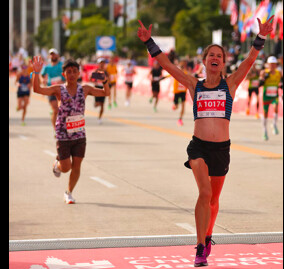Running News Daily
Running News Daily is edited by Bob Anderson. Send your news items to bob@mybestruns.com Advertising opportunities available. Train the Kenyan Way at KATA Kenya and Portugal owned and operated by Bob Anderson. Be sure to catch our movie A Long Run the movie KATA Running Camps and KATA Potato Farms - 31 now open in Kenya! https://kata.ke/
Index to Daily Posts · Sign Up For Updates · Run The World Feed
6 Mistakes You Make When Looking at a Marathon Course Map
Set yourself up for success with tips from professional course measurers and cartography experts.
When you sign up for a race, it’s pretty standard to look at the course map. You may note the obvious points, like the start and finish, key mile markers, elevation, and any interesting monuments or sights along the way. But there’s another layer of helpful information to uncover if you know what to look for. Taking a closer look may even help you score a PR for that half marathon or full 26.2.

In interviews with professional course measurers and cartography experts, we outlined some mistakes you’re probably making when studying a course map. Here are six ways you can level up your preparation for race day.
You Miss Out on Tangents
You should definitely study the course map well in advance. A course map reveals key information that can give you an edge over the competition, says Neyl Marquez, a USA Track and Field course certifier and World Athletics course measurer.
For example, a course map reveals the tangents to utilize in racing. In cross-country and road races, “running the tangents” refers to covering the shortest possible distance from one point to another. In road racing, this typically means running on the inside curve of the road at all times. It’s also a tactic that can sometimes make or break a PR attempt.
Studying a course map will show you the number of turns and the distance between one turn and the next, Marquez points out. This can help you to plan which side of the road you should run to efficiently navigate the following turn and avoid running longer than necessary. For example, if you know there will be a series of hard turns on a road 5K that go left, right, left, you’ll want to make your way toward the following side or at least the middle of the road heading into the next turn. “It makes a difference at what point you decide to start running toward that next available turn, and that’s knowing the course,” Marquez says.
You Overlook the Shape of the Course
Studying a course map will help you visualize the type of race
It’s also important to plan for the 90-degree turns, so you can run them efficiently and not expend too much unnecessary energy. “[For right angle turns] you want to take the turn wide because you can maybe maintain your stride efficiency,” he says. “If you take the turns tight, you’re going to have to slow down at the turn and then accelerate out.”
You Skim Over the Terrain
Race organizers of hillier courses will include an elevation profile along with the course map, and it’s key to examine the topography before race day. For some races with notorious hills, i.e. the Boston Marathon and New York City Marathon, it’s critical to incorporate specific hill grades into your training.
Knowing where to expect the inclines and declines is also helpful when determining how to strategize effort during the race, Hartnett says. He created the elevation profile for the New York City Marathon, which includes bridge ascents and various uphills throughout the city, but the course also features several flat and downhill sections runners should take advantage of, he notes.
You Don’t Examine the Aid Stations
Most course maps indicate where the aid stations are located on the course, which is
Login to leave a comment




